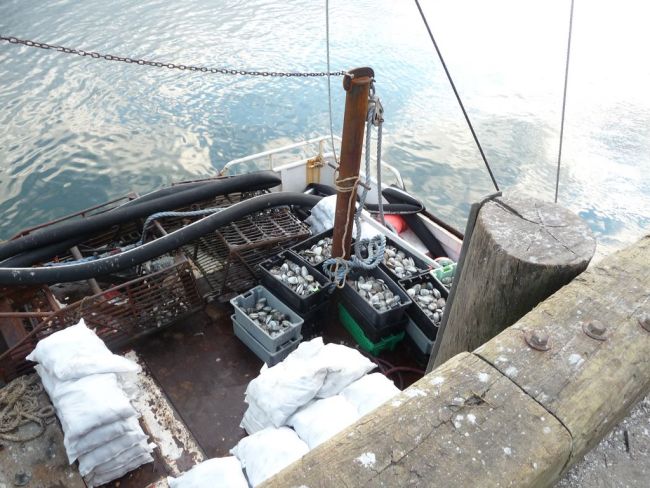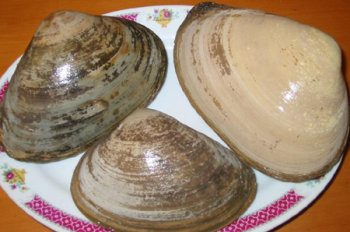Took this pic of a clamming boat coming into dock in Wellfleet in September a couple of years ago. The refrigerated truck will arrive just as he ties up.

Those are Sea Clams which are harvested along the Northeast coast by dredging, from deeper water than the Quahog of the tidal flats but much shallower waters than those inhabited by the deep-sea Ocean Clam. Here are Sea Clams up close:

Sea Clams are the main processed clam in the US, and their shells are commonly used as ashtrays.
The hard-shelled clam, the Quahog (Mercenaria mercenaria - why that name?) is the clam of Atlantic US estuaries and tidal flats. It tastes better, in my opinion, than the Sea Clam - especially when you dig them yourself. Unlike the Sea Clam, you eat the Quahog feathers and all: Littlenecks and Cherrystones - and the chowder-sized Quahogs.
This is from Thoreau's Cape Cod:
We found some large clams, of the species Mactra solidissima, which the storm had torn up from the bottom, and cast ashore. I selected one of the largest, about six inches in length, and carried it along, thinking to try an experiment on it. We soon after met a wrecker, with a grapple and a rope, who said that he was looking for tow cloth, which had made part of the cargo of the ship Franklin,(17) which was wrecked here in the spring, at which time nine or ten lives were lost. The reader may remember this wreck, from the circumstance that a letter was found in the captain's valise, which washed ashore, directing him to wreck the vessel before he got to America, and from the trial which took place in consequence.(18) The wrecker said that tow cloth was still cast up in such storms as this. He also told us that the clam which I had was the sea-clam, or hen, and was good to eat. We took our nooning under a sand-hill, covered with beach-grass, in a dreary little hollow, on the top of the bank, while it alternately rained and shined. There, having reduced some damp drift-wood, which I had picked up on the shore, to shavings with my knife, I kindled a fire with a match and some paper, and cooked my clam on the embers for my dinner; for breakfast was commonly the only meal which I took in a house on this excursion. When the clam was done, one valve held the meat and the other the liquor. Though it was very tough, I found it sweet and savory, and ate the whole with a relish. Indeed, with the addition of a cracker or two, it would have been a bountiful dinner. I noticed that the shells were such as I had seen in the sugar-kit at home. Tied to a stick, they formerly made the Indian's hoe hereabouts.
The entirety of Thoreau's report of his amusing 1849-1867 ramblings, Cape Cod, can be read here.


